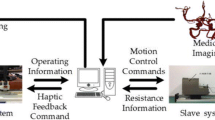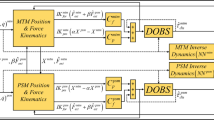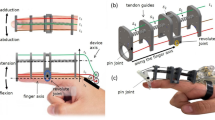Abstract
At present, surgical master-slave systems lack any kind of force feedback. Typically, controllers giving good stiffness transparency for soft environments cannot guarantee stability during hard contact. This paper presents a pragmatic method to avoid instability of a master-slave system during hard contacts, which does not affect the stiffness reflection for soft environments. The time derivative of the interaction force with the environment is used to detect a hard contact. Upon detection of a hard contact the force feedback is switched off and a virtual wall is activated at the master side in order to guarantee the perception of hard contact by the operator. The experiments demonstrate good stiffness transparency for soft environments, while the system remains stable for both soft and hard environments.
Preview
Unable to display preview. Download preview PDF.
Similar content being viewed by others
References
Deml, B., Ortmaier, T., Seibold, U.: The touch and feel in minimally invasive surgery. In: Proceedings of International Workshop on Haptic Audio Visual Environments and their Applications, Ontario, Canada, pp. 33–36 (October 2005)
Wagner, C.R., Stylopoulos, N., Howe, R.D.: The role of force feedback in surgery: Analysis of blunt dissection. In: The 10th Symp. on Haptic interfaces for virtual environment and teleoperator systems, Orlando (2002)
Richards, C., Rosen, J., Hannaford, B., Pellegrini, C., Sinanan, M.: Skills evaluation in minimally invasive surgery using force/torque signatures. Surg. Endosc. 14(9), 791–798 (2000)
Cavusoglu, M.C., Sherman, A., Tendick, F.: Bilateral controller design for telemanipulation in soft environments. IEEE Transactions on Robotics and Automation 18(4), 641–647 (2002)
De Gersem, G., Van Brussel, H., Vander Sloten, J.: Enhanced haptic sensitivity for soft tissues using teleoperation with shaped impedance reflection. In: Proceedings of the World Haptics Conference, Pisa, Italy (March 2005)
Misra, S., Okamura, A.M.: Environment parameter estimation during bilateral telemanipulation. In: Proceedings of Symposium on Haptic Interfaces for Virtual Environment and Teleoperator Systems, Virginia, USA, pp. 301–307 (March 2006)
Malysz, P., Siroupour, S.: Stable non-linear force/position mapping for enhanced telemanipulation of soft environments. In: Proceedings of the International Conference on Robotics and Automation, Roma, Italy, pp. 4307–4312 (April 2007)
Yokokohji, Y., Yoshikawa, T.: Bilateral control of master-slave manipulators for ideal kinesthetic coupling. IEEE transactions on robotics and automation 10(5), 605–620 (1994)
Colgate, J.E.: Robust impedance shaping telemanipulation. IEEE Transactions on robotics and automation 9(4), 374–384 (1993)
Anderson, R.J., Spong, M.W.: Bilateral control of teleoperators with time delay. In: Proceedings of IEEE international conference on Systems, Man & Cybernetics, Bejing, China, vol. 1, pp. 131–138 (August 1988)
Raju, G.R., Verghese, G.C., Sheridan, T.B.: Design issues in 2-port network models of bilateral remotemanipulation. In: Proceedings of the IEEE International Conference on Robotics and Automation, Scottsdale, AZ, vol. 3, pp. 1316–1321 (May 1898)
Hu, Z., Salcudean, S.E., Loewen, P.D.: Robust controller design for teleoperation systems. In: Proceedings of the IEEE International Conference on Systems, Man and Cybernetics, vol. 3, pp. 2127–2132 (1995)
Vander Poorten, E., Yokokohji, Y., Tsuneo, Y.: Stability analysis and robust control for fixed-scale teleoperation. Advanced Robotics 20, 681–706 (2006)
Hannaford, B., Ryu, J.: Time domain passivity control of haptic interfaces. In: Proceedings of the IEEE International Conference on Robotics and Automation, Seoul, Korea, pp. 1863–1869 (May 2001)
Ryu, D., Song, J.-B., Choi, J., Kang, S., Kim, M.: Frequency domain stability observer and active damping control for stable haptic interaction. In: Proceedings of the IEEE International Conference on Robotics and Automation, Roma, Italy, pp. 105–110 (April 2007)
Kim, Y.S., Hannaford, B.: Some practical issues in time domain passivity control of haptic interfaces. In: Proceedings of the IEEE International Conference on Intelligent Robots and Systems, Manui, Hawaii, pp. 1744–1750 (October 2001)
Author information
Authors and Affiliations
Editor information
Rights and permissions
Copyright information
© 2008 Springer-Verlag Berlin Heidelberg
About this paper
Cite this paper
Willaert, B., Vander Poorten, E., Reynaerts, D., Van Brussel, H. (2008). A Pragmatic Method for Stable Stiffness Reflection in Telesurgery. In: Ferre, M. (eds) Haptics: Perception, Devices and Scenarios. EuroHaptics 2008. Lecture Notes in Computer Science, vol 5024. Springer, Berlin, Heidelberg. https://doi.org/10.1007/978-3-540-69057-3_8
Download citation
DOI: https://doi.org/10.1007/978-3-540-69057-3_8
Publisher Name: Springer, Berlin, Heidelberg
Print ISBN: 978-3-540-69056-6
Online ISBN: 978-3-540-69057-3
eBook Packages: Computer ScienceComputer Science (R0)




